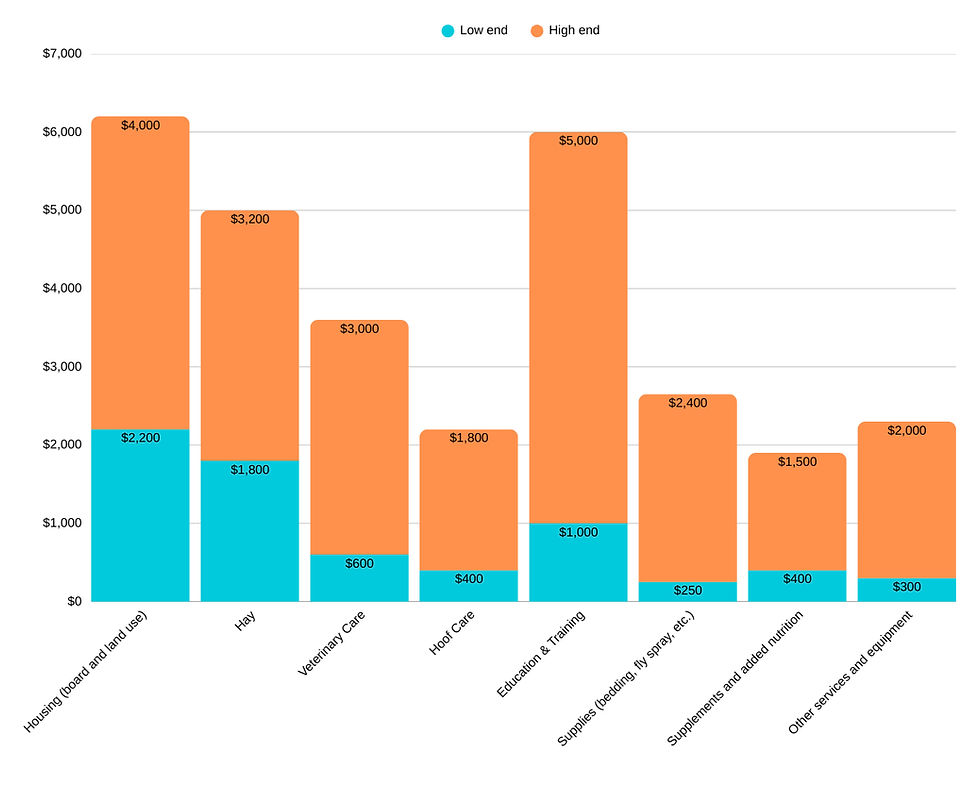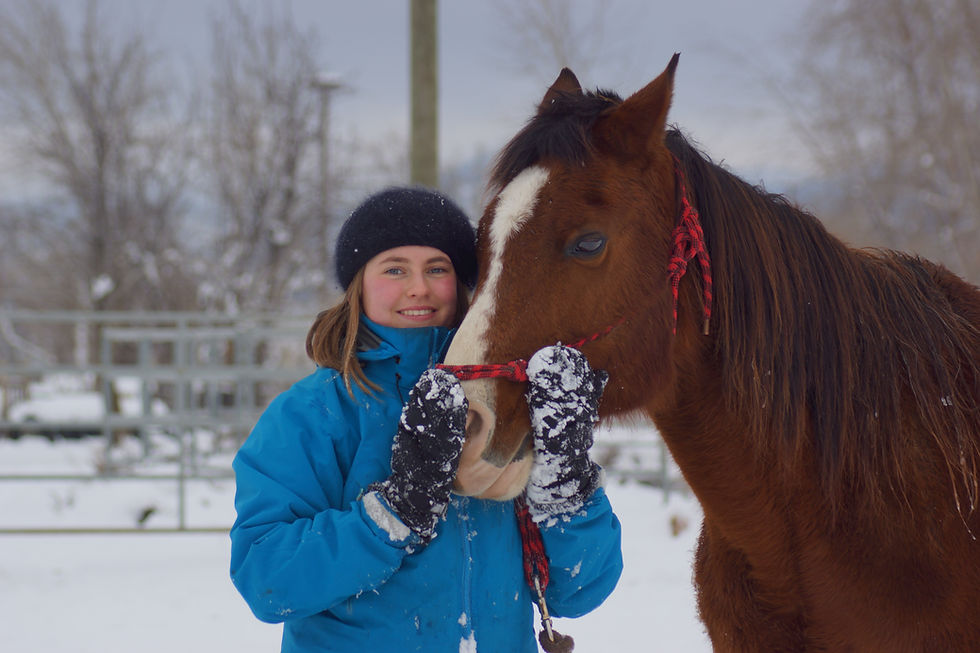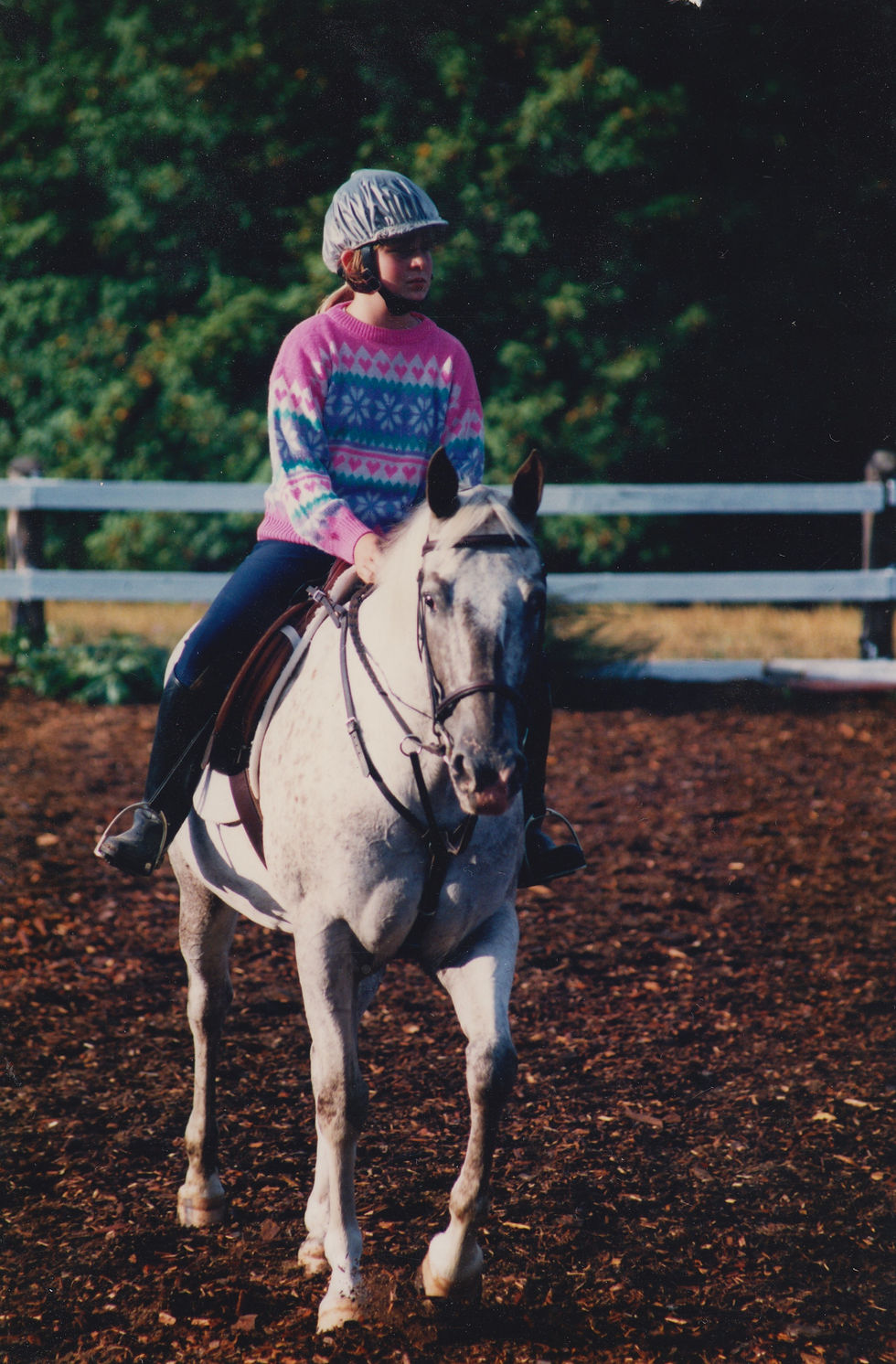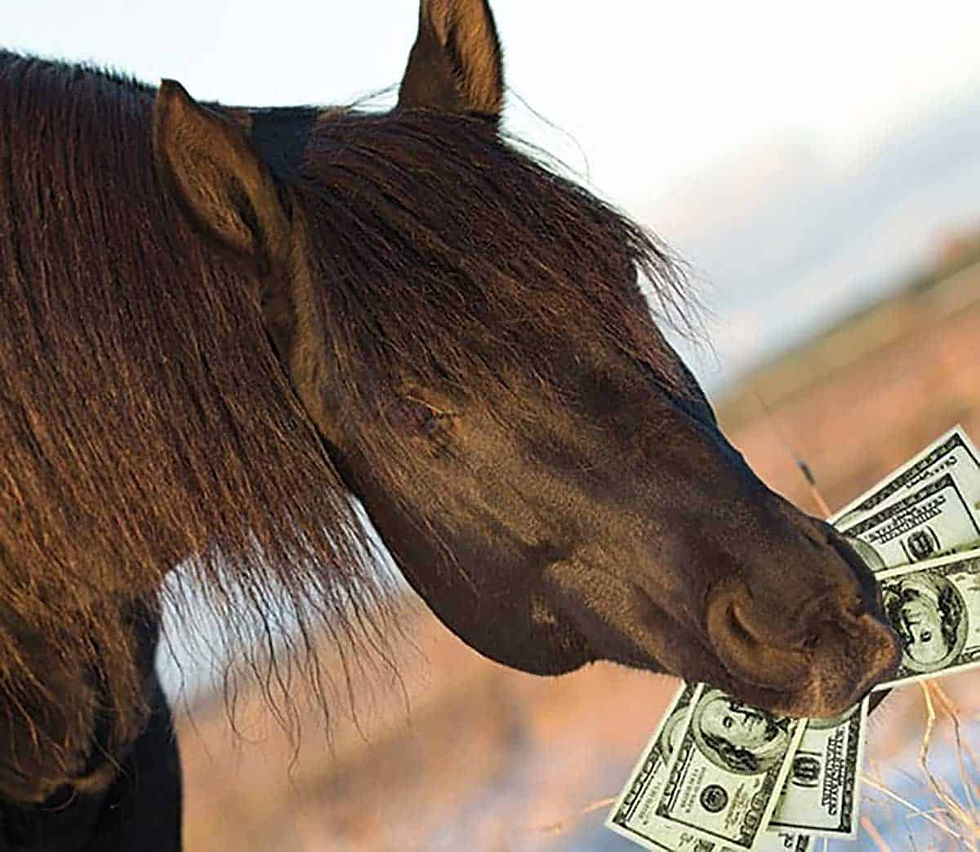How much does a horse cost anyway?
- Leann Manuel

- Sep 19, 2025
- 7 min read
Updated: Sep 23, 2025
Recently, some of our clients have asked the BIG question: "How much does it cost to keep a horse?"
Well... for most of us... quite a bit. And it also depends.
So I looked to my website to send them the link to a post I wrote about this topic. And to my surprise, I found the post was from 2014 and the costs listed there were, well... a little behind.
So here's my updated answer to that BIG question for anyone who's contemplating that next big step in their horsemanship journey.

The purchase and subsequent care of a horse is significant and needs to be thought through carefully. Riding lessons can actually be one of the less costly items when it comes to horsin' around.
Consider also how much time you have to commit to a horse's care. Time is money as they say, and this is very much the case with horses.
At Riding 4 Life, we can't afford to write many big cheques so we put in a lot time and effort to control those costs. We track our time budget just as closely as our monetary one because both of those resources are limited.
Below is a graph of the typical expenses related to horse ownership. These numbers can vary widely across different regions so don't expect this to be accurate in North Vancouver for sure. And while the South Okanagan is certainly much more affordable than a major urban center, compared to rural Saskatchewan these costs will seem extravagant.

Housing your horse
Horse boarding is becoming more difficult to find near urban centers and can cost as much as $1000 per month depending on amenities, location, and services included. In the south Okanagan, fees can range from $180 per month to $300 for just a paddock with no services or feed included. This is described as 'self board'.
'Full' board options in our area are about $650 each month and include your horse's basic needs. But full board does not mean all your horse's daily needs are met. Special medications, treatments, would care, blanketing, grooming, etc. are either not available at most facilities, or they will mean additional charges.
Sometimes boarding will be offered for less than this but there will be trade offs. The facility may not have a riding arena, or secure tack storage. You may be the only other boarder and you may be isolated from a larger community which can be a challenge for newcomers. It may be a considerable distance from your home which will cost you time and fuel.
Feeding your horse

The average horse eats 20 - 25 lbs of hay daily. That's why you'll often hear of hay being measured by the pound or ton. So when purchasing hay you need to consider the weight of the average bale and know what you're paying by the ton to accurately compare prices.
Hay costs range from $12 - $18 per small square bale in our area depending on it's quality. High quality hay is important to a horse's well being and we chose medium to high quality hay for our Riding 4 Life horses. If we don't invest in good hay, we'll be spending more money later in supplements and veterinary costs. And these costs don't reflect the labour involved with loading, hauling, or stacking this hay. Large bales may be cheaper by the pound, but they require heavy equipment to handle them.
Veterinary Care
At minimum, your horse should see the vet once each year for a health check and vaccinations. If you are not an experienced breeder or herdsman there is no avoiding this. All domestic horses will also need regular dental work and intervention for parasites. Ask your vet for recommendations about this at your annual health appointment. If you're lucky, that will be the only time you need to talk to your equine vet.
Horses are fragile creatures in many ways and serious emergencies can arise without warning. Common issues like cuts and somewhat serious injuries arise sometimes. Colic, age related metabolic issues in older horses, and ulcers are other common ailments that can come up. These are difficult to predict and sometimes expensive to treat. A contingency fund of $1000 can go a long way to easing the stress of these unexpected needs.
If you're interested in competing or traveling with your horse, expect to see your vet much more often. Soundness issues, soft tissue injuries, and all the same things that human athletes contend with can happen in equine athletes as well. They may also require additional vaccinations.
Hoof Care
All horses living in domestic environments require professional hoof care. While the average interval is 6-8 weeks for trimming and/or resetting shoes, some horses may need to be trimmed on a shorter cycle. Others who are not shod and have access to large acreages and can walk several miles each day on their own may need attention less often.

Trimming and farrier work also varies quite a bit depending on the needs of your horse. Basic trims in our area range from $50 - $65. Shoeing ranges from $120 - $250 depending on how many shoes and if any added details are needed. If you get into horses you'll hopefully learn a bit about snow pads, clips, traction corks, and many other details.
The needs of each horse can vary quite a bit too. Don't bank on being able to avoid shoes to save money. Fewer than half of our lesson crew at Riding 4 Life thrive without shoes or additional hoof care costs. Some horses require highly specialized and remedial care from professionals with very specific training.
And also remember, horses living in domesticated environments need almost daily attention and monitoring for their hoof health in addition to professional attention.
Education and Training
Many parents compare the cost of owning a horse to the cost of riding lessons. Their thinking seems to be that their child can have a lot more access for not much more money. I call this 'adventures in missing the point'. And they can be very dangerous adventures.

First of all, lesson horses are usually nothing like individually owned horses. Lesson horses are professionally supervised daily and often have 'tune up' rides with highly experienced riders. Your own horse is much more likely to challenge your leadership in ways that are discouraging, frustrating, and even dangerous.
The early days of first horse ownership definitely require ongoing education and training. Never assume that once you've bought the horse that the riding lessons can cease. Over time they may become less regular, however. This will depend on the horse and on the rider and how they are developing together.
If you're keen to get competitive in an equestrian discipline, this training and education can get very expensive. It's hugely rewarding if you enjoy it though and worth every penny for how it can challenge each of us to grow. I see education as the best bang for buck when it comes to enjoying horses. This is definitely a world where what you don't know can hurt you - and cost you a lot more money!
Supplies
The costs of all the little things can really add up. Things like fly spray, shavings for bedding, brushes, and did I mention fly spray? This year has been a particularly bad year for airborne parasites and Riding 4 Life blew through its usual allotment of products for the year by early August. It's now late September as I write this and the bugs are unrelenting!
Be sure and consider the $40 here, and the online order there. And don't forget the braiding elastics, shampoo, and colour coordinated leg wraps. Hopefully there's some family around who likes to gift shop from a wish list to help cover some of these costs!
Supplements and additional nutrition
Horses need dietary supplements to ensure they get adequate vitamins and minerals. The soil in our region is deficient in iodine and selenium so those are a must. None of the hay grown in the Okanagan will have enough of those minerals to support your horse long term.

If your hay does not have enough protein or accessible calories then you will likely need to add a concentrate of some kind. Historically we've done that by adding grains like oats. Today there are literally hundreds of options at the local feed store. Again your vet or instructor may have some great suggestions of where to start with your horse.
Some horses, especially mature horses may have poor teeth or an age related health issues that mean they require extra feed as well. These costs will add up on top of your hay costs.
Other services and equipment
Other services can include the chiropractor or massage therapist. The saddle fitter is another professional you may meet on your journey. These folks are all money well spent if you're working with someone reputable and they can often save you money and increase quality of life in the long run.
While riding equipment is usually pretty durable, you will likely start out with entry level items until you discover what you specifically want to focus on. The sky is the limit when it comes to equipment costs so you will need to prioritize wisely.
Equipment that you may need to purchase every year or two may include horse blankets, boots, a saddle pad, and of course the matching leg wraps or halter to go with it. The estimate in the graph above is a very conservative one. Once again, a competitive rider could easily double or triple that budget in a year.
The grand total?

From the costs compiled in the graph above you can see that the annual price tag of horse ownership can vary anywhere from about $7,000 to more than $20,000. And that doesn't include purchasing the horse! It's a bit intimidating for sure.
However, for those of us who have that twinkle in our eye, it is one of the greatest investments you can make in a young person as far as human development, character growth, and transferable skills for a life that requires resiliency, creativity, and discipline.
I may be a bit biased, but I highly recommend mounting up for the challenge!




Comments